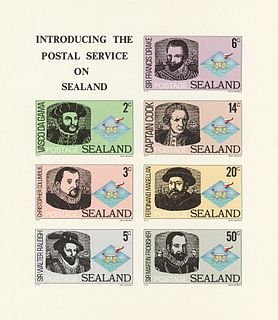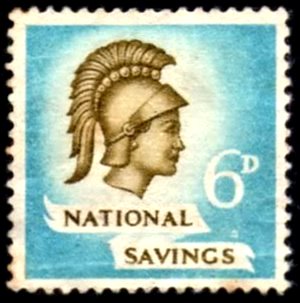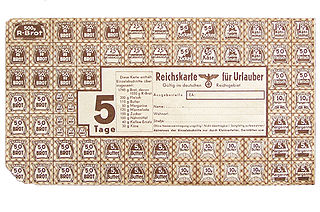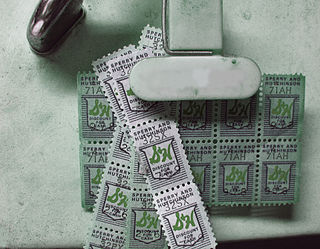 W
WIn philately, a cinderella stamp is "virtually anything resembling a postage stamp, but not issued for postal purposes by a government postal administration". There is a wide variety of cinderella stamps, such as those printed for promotional use by businesses, churches, political or non-profit groups. The term excludes imprinted stamps on postal stationery.
 W
WAn airmail etiquette, often shortened to just etiquette, is a label used to indicate that a letter is to be sent by airmail. The term is from French étiquette "label, sticker", from which also comes the English word etiquette "rules of behavior".
 W
WThe Azad Hind stamps are a set of prepared but never issued stamps for the planned Provisional Government of Free India under Subhas Chandra Bose. All stamps were printed by photogravure in sheets of 100 at the Reichsdruckerei, the Government Printing Bureau in Berlin.
 W
WBlue Chip Stamps started as a trading stamps company called "Blue Chip Stamp Co." They were a competitor of S&H Green Stamps. Blue Chip stamps were a loyalty program for customers, similar to discount cards issued by pharmacies and grocery stores in the digital era. A customer making a purchase at a participating store would be given stamps in proportion to the dollar amount of the purchase. The stamps were dispensed by machines adjacent to the cash register. The customer would paste the stamps into books. The books could then be taken to a redemption center and redeemed for merchandise, such as lawn furniture, dining tables, tableware, and many other items. The redemption centers did not maintain a full inventory of items but would order from a catalog on behalf of the customer.
 W
WA charity label is a label resembling a postage stamp, sold by charities to raise funds. They are generally intended to be used on mail, as a way of advertising the sender's support of the charity's cause.
 W
WThe Chinchen Collection is a collection of stamps, proofs, artwork and covers from Lundy Island donated by Barry Chinchen to the British Library Philatelic Collections in 1977 and is located at the British Library.
 W
WChristmas seals are labels placed on mail during the Christmas season to raise funds and awareness for charitable programs. They have become particularly associated with lung diseases such as tuberculosis, and with child welfare. Christmas seals are regarded as a form of cinderella stamp in contrast with Christmas stamps used for postage.
 W
WThe Cinderella Stamp Club was founded on 5 June 1959 in London, England, and is an association of philatelists, amateur and professional, whose interests lie in local stamps, telegraph stamps, railway stamps, revenue stamps, fiscals, forgeries, bogus and phantom issues, Christmas, Red Cross, TB and other charity seals, registration labels, advertisement and poster stamps and many other items - all of which are the so-called "Cinderellas of Philately".
 W
WIn postal history, a circular delivery company was a type of company which operated in Great Britain between 1865 and 1869 to deliver circulars and other printed matter at rates lower than the British Post Office charged. The service was outlawed in 1869 and a new cheaper postage rate for printed matter introduced in 1870. The stamps issued by the companies are much sought after by philatelists.
 W
WThe Principality of Sealand, a micronation founded on a former World War II fort in the North Sea, has issued a number of coins and stamps for collectors. These coins and stamps are denominated in "Sealand dollars" (SX$). Sealand coins can be considered souvenirs only or "rounds" since they do not circulate anywhere and are not accepted as currency by any nation.
 W
WThe Contributions Agency Collection is a collection of British National Insurance stamps that forms part of the British Library Philatelic Collections.
 W
WGaston Aime Camille Fontanille, also known just as Delandre, was a French entrepreneur and conman born in Valence, the son of a magistrate.
 W
WAn Easter seal is a form of charity label issued to raise funds for charitable purposes. They are issued by the Easterseals charity in the United States, and by the Canadian Easter Seals charities.
 W
WThe Ewen Collection is a collection of railway letter stamps of the United Kingdom from 1891 to 1912 that forms part of the British Library Philatelic Collections. It was formed by Herbert L'Estrange Ewen and donated in 1949 by his sister Mrs Clement Williams.
 W
WGreen Shield Stamps was a British sales promotion scheme that rewarded shoppers with stamps that could be used to buy gifts from a catalogue or from any affiliated retailer. The scheme was introduced in 1958 by Richard Tompkins, who had noticed the success of the long-established Sperry & Hutchinson Green Stamps in America.
 W
WThe H.M. Stationery Office Collection is a collection of British excise revenue material including National Savings and National Insurance stamps that forms part of the British Library Philatelic Collections. It was received from H.M.S.O. between 1982 and 1992.
 W
WHotel Post was a service offered by remote Swiss hotels for the carriage of mail to the nearest official post office.
 W
WThe Langmead Collection is a collection of British and Irish telegraph stamps and stationery from 1851 to 1881 that forms part of the British Library Philatelic Collections. It was formed by Peter Langmead and received by the Library under the "in lieu of tax" scheme in 1991.
A local post is a mail service that operates only within a limited geographical area, typically a city or a single transportation route. Historically, some local posts have been operated by governments, while others, known as private local posts have been for-profit companies. Today, many stamp collectors operate hobbyists' local posts, issuing their own postal "stamps" for other collectors but rarely carrying any mail.
 W
WLocal postal surcharge labels are a class of labels applied widely to Chinese internal mail between January 1987 and February 1999. They have also been called Additional Charge Labels and Added Charge Labels.
 W
WThis is an article about the postage stamps and postal history of the Sovereign Military Order of Malta.
 W
WThe poster stamp was an advertising label, a little larger than most postage stamps, that originated in the mid-19th century and quickly became a collecting craze, growing in popularity until World War I and then declining by World War II until they were almost forgotten except by collectors of cinderella stamps.
 W
WIn philately a railway stamp is a stamp issued to pay the cost of the conveyance of a letter or parcel by rail.
 W
WA ration stamp, ration coupon or ration card is a stamp or card issued by a government to allow the holder to obtain food or other commodities that are in short supply during wartime or in other emergency situations when rationing is in force. Ration stamps were widely used during World War II by both sides after hostilities caused interruption to the normal supply of goods. They were also used after the end of the war while the economies of the belligerents gradually returned to normal. Ration stamps were also used to help maintain the amount of food one could hold at a time. This was so that one person would not have more food than another.
 W
WA revenue stamp, tax stamp, duty stamp or fiscal stamp is a (usually) adhesive label used to collect taxes or fees on documents, tobacco, alcoholic drinks, drugs and medicines, playing cards, hunting licenses, firearm registration, and many other things. Typically, businesses purchase the stamps from the government, and attach them to taxed items as part of putting the items on sale, or in the case of documents, as part of filling out the form.
 W
WS&H Green Stamps were a line of trading stamps popular in the United States from 1896 until the late 1980s. They were distributed as part of a rewards program operated by the Sperry & Hutchinson company (S&H), founded in 1896 by Thomas Sperry and Shelley Byron Hutchinson. During the 1960s, the company promoted its rewards catalog as being the largest publication in the United States and boasted that it issued three times as many stamps as the U.S. Postal Service. Customers received stamps at the checkout counter of supermarkets, department stores, and gasoline stations among other retailers, that could be redeemed for products in the catalog. Top Value Stamps, acquired by Tom Ficara in 1990 and now a division of TVS Television Network, and S&H are the only two surviving legacy stamp programs.
 W
WA savings stamp is a stamp issued by a government or other body to enable small amounts of money to be saved over time to accumulate a larger capital sum. The funds accumulated may then be used to make a larger purchase such as taking out a savings bond or to pay a large upcoming bill. Often issued in conjunction with post office run savings banks, savings stamps have also been issued by private companies. Supermarkets have issued the stamps to enable the spreading of large bills, package holiday companies have used them to enable customers to save for an annual holiday, and utilities companies have used the stamps to enable customers to spread the cost of their bills.
 W
WTelegraph stamps are stamps intended solely for the prepayment of telegraph fees. The customer completed a telegraph form before handing it with payment to the clerk who applied a telegraph stamp and cancelled it to show that payment had been made. If the stamp was an imprinted stamp, it formed part of the message form.
 W
WTrading stamps are small paper stamps given to customers by merchants in loyalty programs that predate the modern loyalty card. Like the similarly-issued retailer coupons, these stamps only had a minimal cash value of a few mils individually, but when a customer accumulated a number of them, they could be exchanged with the trading stamp company for premiums, such as toys, personal items, housewares, furniture and appliances.
 W
WThe Turner Collection of Railway Letter Stamps is a collection of railway letter stamps of the United Kingdom from 1891 to the mid-1940s that forms part of the British Library Philatelic Collections. It was formed by S.R. Turner and donated in 1973.